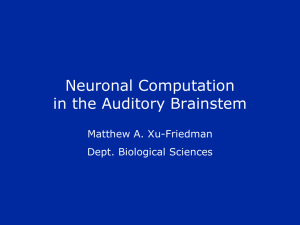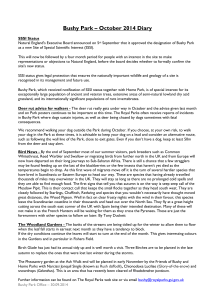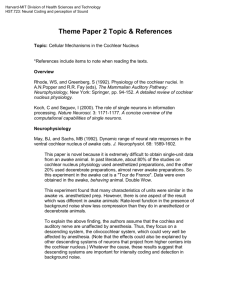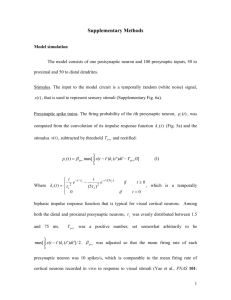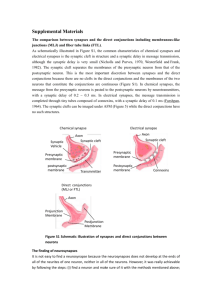BOX 25.3 GIANT SYNAPTIC TERMINALS: ENDBULBS AND
advertisement
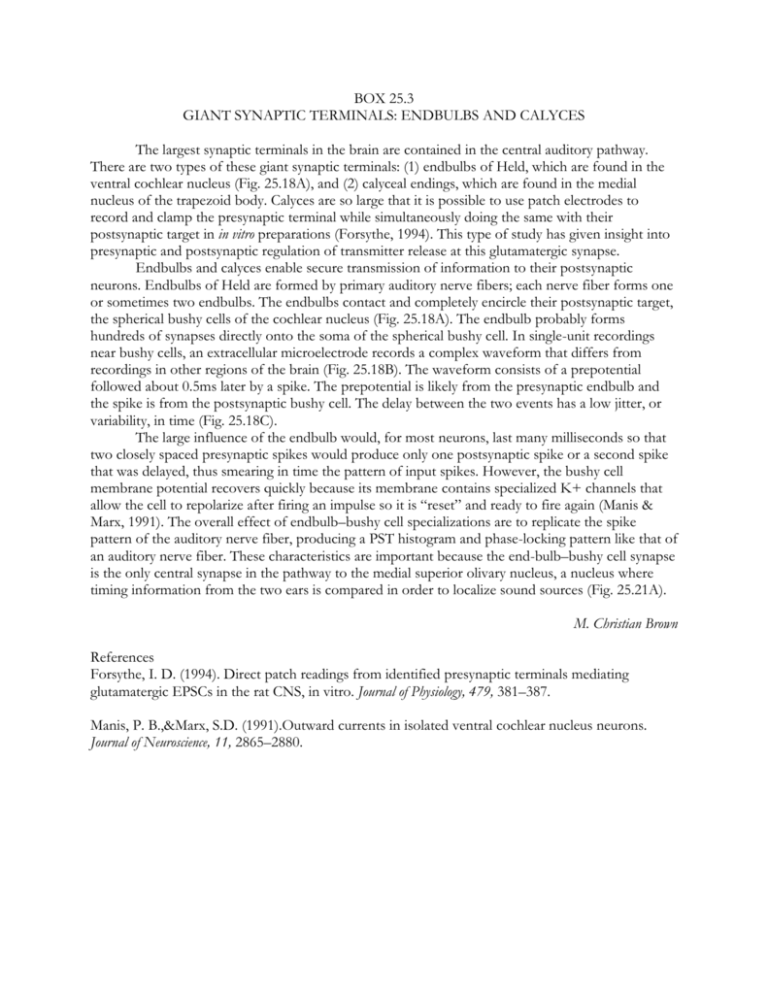
BOX 25.3 GIANT SYNAPTIC TERMINALS: ENDBULBS AND CALYCES The largest synaptic terminals in the brain are contained in the central auditory pathway. There are two types of these giant synaptic terminals: (1) endbulbs of Held, which are found in the ventral cochlear nucleus (Fig. 25.18A), and (2) calyceal endings, which are found in the medial nucleus of the trapezoid body. Calyces are so large that it is possible to use patch electrodes to record and clamp the presynaptic terminal while simultaneously doing the same with their postsynaptic target in in vitro preparations (Forsythe, 1994). This type of study has given insight into presynaptic and postsynaptic regulation of transmitter release at this glutamatergic synapse. Endbulbs and calyces enable secure transmission of information to their postsynaptic neurons. Endbulbs of Held are formed by primary auditory nerve fibers; each nerve fiber forms one or sometimes two endbulbs. The endbulbs contact and completely encircle their postsynaptic target, the spherical bushy cells of the cochlear nucleus (Fig. 25.18A). The endbulb probably forms hundreds of synapses directly onto the soma of the spherical bushy cell. In single-unit recordings near bushy cells, an extracellular microelectrode records a complex waveform that differs from recordings in other regions of the brain (Fig. 25.18B). The waveform consists of a prepotential followed about 0.5ms later by a spike. The prepotential is likely from the presynaptic endbulb and the spike is from the postsynaptic bushy cell. The delay between the two events has a low jitter, or variability, in time (Fig. 25.18C). The large influence of the endbulb would, for most neurons, last many milliseconds so that two closely spaced presynaptic spikes would produce only one postsynaptic spike or a second spike that was delayed, thus smearing in time the pattern of input spikes. However, the bushy cell membrane potential recovers quickly because its membrane contains specialized K+ channels that allow the cell to repolarize after firing an impulse so it is “reset” and ready to fire again (Manis & Marx, 1991). The overall effect of endbulb–bushy cell specializations are to replicate the spike pattern of the auditory nerve fiber, producing a PST histogram and phase-locking pattern like that of an auditory nerve fiber. These characteristics are important because the end-bulb–bushy cell synapse is the only central synapse in the pathway to the medial superior olivary nucleus, a nucleus where timing information from the two ears is compared in order to localize sound sources (Fig. 25.21A). M. Christian Brown References Forsythe, I. D. (1994). Direct patch readings from identified presynaptic terminals mediating glutamatergic EPSCs in the rat CNS, in vitro. Journal of Physiology, 479, 381–387. Manis, P. B.,&Marx, S.D. (1991).Outward currents in isolated ventral cochlear nucleus neurons. Journal of Neuroscience, 11, 2865–2880. FIGURE 25.18 (A) Drawing of a labeled auditory nerve fiber forming an endbulb of Held that completely envelops a spherical bushy cell in the anteroventral cochlear nucleus. From Rouiller et al. (1986). (B) Superimposed waveforms recorded by an extracellular metal electrode in the anteroventral cochlear nucleus. The endbulb is such a large synaptic ending that it generates a prepotential, which is followed after a synaptic delay by the spike from the bushy cell. From Pfeiffer (1966). (C) Histogram of the delay time between prepotential and spike. This represents the synaptic delay between endbulb and bushy cell. The delay of this synapse has an exceptionally low jitter in time. From Molnar and Pfeiffer (1968).
